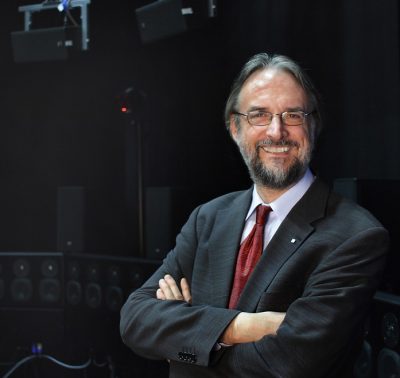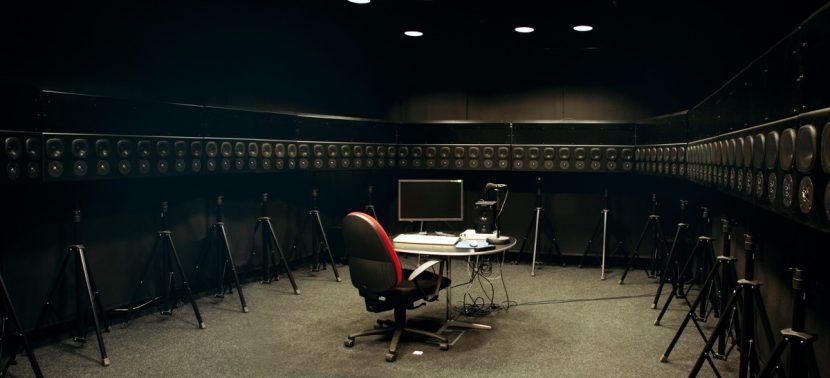fxguide is once again a media partner and the official podcast of SIGGRAPH Asia. This year the conference is being held in Singapore from November 28th to December 1st. In the coming months, we’ll be profiling several of the main speakers, technical talks, courses and events to be held. We start this week with featured speaker Professor Karlheinz Brandenburg, the so-called ‘father of MP3.’
At first glance, it might seem unusual for one of the inventors of MP3 to be invited as a featured speaker at a computer graphics conference. But look deeper into Professor Brandenburg’s research behind one of the most ubiquitous technologies in recent history, and his promising continued developments into enriching the audio experience, and it becomes clearer how the example of his research can be applied to other innovations traditionally presented at SIGGRAPH conferences.
The story of MP3

Now the Director of the Fraunhofer Institute for Digital Media Technology IDMT in Ilmenau, Germany, Professor Brandenburg was one of the major contributors to audio compression format MPEG Audio Layer 3 – MP3. The Professor will be telling the story of MP3 at SIGGRAPH Asia 2012 – a story that begins much earlier than even Brandenburg’s own research in the early 1980s. “The idea of doing audio compression came from my PhD thesis adviser,” says Brandenburg. “He wanted to get better quality signals over phone lines initially, especially the ability to send music over phone lines, which when he thought of it in the late 70s was completely impossible.”
The standardization of the MP3 format, of which Brandenburg was one of many contributors resulted in the first public release of MPEG-1 Audio Layer III (ISO/IEC 11172-3) in 1993. Of course, this release and later versions of MP3 came right as Internet usage was exploding worldwide. People began not only sharing MP3s online, but also used new software to ‘organize’ their music collections – and eventually led to the success of tech such as Apple’s iPod and iTunes store and personal music organization – something that actually came as a surprise to Brandenburg and his team at the time.
“We thought the big music labels would distribute music over the Internet or other channels, but still would be in full control,” he says. “What we did not anticipate was that people would want to have their own control, zip their CDs and of course use other illegal sources for music. I didn’t anticipate at the time that people would do this themselves and burn their own CDs and put it in their car radio and listen to more music than what was available before.”
However, semiconductor based memory storage was at the forefront of Brandenburg’s mind in those days. “With Moore’s Law, it was easy to extrapolate a time when memory would be cheap enough to hold music and be a storage medium. But this idea that people would use their own computers and make music and distribute it themselves – that is something I’m happy about but came as something of a surprise.”
A new ultimate listening experience
Brandenburg remains at the forefront of audio research – his more recent area of interest is in wave field synthesis – a spatial ‘3D’ audio rendering technique that is based on the creation of virtual acoustic environments. “Using a ring of loudspeakers around a room,” he explains, “you can with quite some fidelity re-create the physical wavefronts of a soundwave in a room. That by itself doesn’t sound spectacular – what this means is there’s a virtual sound source, unlike with normal surround sound where if you move around it’s not the same. With wave field synthesis, you can walk around in the room and it’s stable.”

For example, one such system is used at an attraction at Disneyworld where ghosts appear to be whispering in your ear. Brandenburg says the same technology can be used to listen to a symphony orchestra and get the feeling you are in the audience. A spin-off company – IOSONO – markets the tech as a 3D sound solution, and has installations in concert halls, museums, cinemas, planetariums and research facilities. With so much recent talk about the advent of high-frame rate and immersive cinema, it would seem that audio – often touted as being 50% of the movie-going experience – should perhaps also be part of that conversation.
How is this different to current surround systems like 5.1 or 7.1? Well, put simply, the difference is in the storage of the music or sound signal, as Brandenburg notes: “These current systems are channel-based – and can re-create the right sound intensities at one spot – the so-called sweet spot – in the room. But that’s different to the way our ears and our brains work, because we get as humans a lot of directional information and distance information from moving around and moving our head a little bit, and the brain uses these changes in the sound to get the feeling where the sound is coming from. You can see this if you watch blind people because for them it becomes necessary to be able to detect where sound is coming from, so they tend to move their heads all the time.”
“With wave field synthesis technology,” adds Brandenburg, “you have an object-based storage of the audio tracks. That means we store up to 32 different sound sources and where they should come from – what their virtual positions are. Then the actual rendering system uses its knowledge about the position of the loudspeakers wherever they are, and then controls all the separate loudspeakers to produce the right illusion.”
– Above: How the film Immortals was mixed in IOSONO 3D sound.
For Professor Brandenburg, the opportunity to speak at SIGGRAPH Asia is a way of highlighting the impact and progress of research, marketing and innovation. “I want my talk at SIGGRAPH Asia to be an example of technology which really changed the lives of people,” he says. It’s an aspect many SIGGRAPH
attendees will recognize when they see how technical research presented at past conferences often makes its way into production and use across many different fields.
For more information about SIGGRAPH Asia 2012, head over to http://www.siggraph.org/asia2012.
